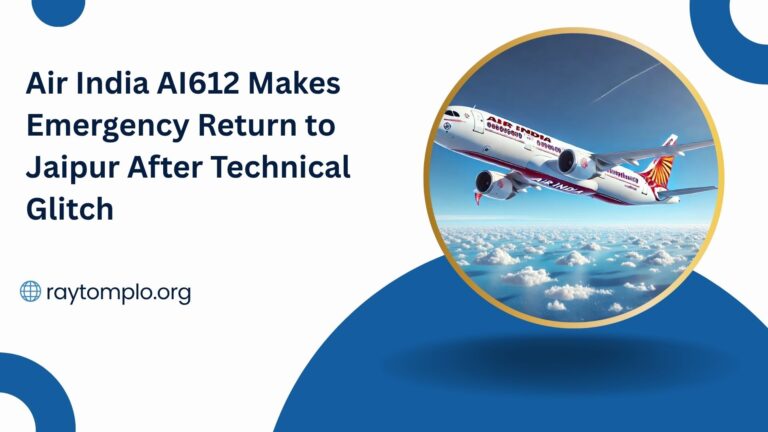Air India Flight AI612, en route from Jaipur to Mumbai, made an emergency return to Jaipur International Airport shortly after takeoff due to a suspected technical issue. Air Traffic Control was promptly informed, and the aircraft, airborne for approximately 18 minutes, turned back so the crew could troubleshoot while ensuring safe descent and landing. This action reflected Air India’s strict adherence to aviation safety protocols and commitment to passenger safety.
The flight crew acted swiftly upon detecting the potential fault by following established safety checklists, communicating with Air Traffic Control, and preparing the cabin for a potential emergency. Upon return, ground engineers conducted a thorough technical inspection, and all mandatory safety checks were completed in full compliance with the airline’s operational procedures.
While the return caused some delay, the airline’s response highlights its proactive safety-first approach. Investigations were carried out promptly before flight operations resumed.
Reed more: Hersheypark Tragedy – Drowning or Seizure Behind 9-Year-Old’s Death? Online Debate Intensifies
Adhering to Safety Protocols for Passenger Protection
Air India confirmed that Flight AI612, operating from Jaipur to Mumbai, returned to Jaipur International Airport shortly after takeoff due to a suspected technical issue. The airline emphasized that passenger and crew safety remains the highest priority.
The decision to return aligns with international aviation safety protocols, which require immediate action for technical anomalies. Air India demonstrated its adherence to operational standards and proactive safety measures.
Though the return may have caused inconvenience, the crew’s quick response ensured all necessary checks were carried out, reinforcing the airline’s reputation for safe air travel.
Comprehensive Inspection and Resolution
After returning to Jaipur, Air India Flight AI612 underwent a comprehensive inspection. Engineers determined the initial warning was a false alert, and no issues were found in the aircraft’s systems.
Once all safety protocols and system checks were completed, the aircraft was cleared for departure. The flight resumed its journey to Mumbai after a short delay.
Air India’s handling of the incident highlights its commitment to safety and clear communication. By following strict protocols, the airline reinforced its dedication to safe air travel.
Ensuring Ongoing Safety Focus
The incident involving Air India Flight AI612 underscores the importance of continuous system monitoring and rigorous maintenance both before and during flights. Even with pre-flight checks, unexpected issues can arise, showing the importance of responsive safety systems.
Air India’s swift handling of the situation exemplified best practices in aviation safety. The prompt actions ensured any risk was addressed, showcasing operational safety and regulatory compliance.
While diagnostic technologies are instrumental in detecting irregularities, human oversight remains essential. The coordinated response demonstrated the airline’s adherence to international safety standards.
The event underscores the need for vigilance, continuous improvement in aviation systems, and relying on both technology and expertise for top safety.
Context of Safety Concerns in the Indian Airline Industry
The emergency return of Air India Flight AI612 is not isolated in India’s airline sector. Two days earlier, an Air India Express flight from Calicut also returned shortly after takeoff due to an air conditioning malfunction. Both were precautionary actions to ensure safety, highlighting Indian carriers’ adherence to strict safety protocols.
Recent data from the DGCA shows that Indian airlines reported 183 technical defects across five major carriers as of July 21. Air India and Air India Express accounted for 85 cases, reflecting the scale of their operations and the importance of proactive safety procedures.
These events highlight the challenges of the aviation sector, where technical issues may still occur despite inspections. The key lies in swift, decisive management—demonstrated by the response to Flight AI612.
Reaffirming Commitment to Passenger Safety
While events like emergency returns can cause concern, passengers should understand that such incidents are rare and are handled with caution. The aviation industry operates under strict regulations, with safety being the top priority.
Although unscheduled returns may seem inconvenient, they eliminate risk and keep everyone safe. For Flight AI612, Air India’s swift action—a prompt check and full protocols—resolved the issue efficiently and minimized passenger disruption.
This incident also demonstrates the robust safety systems and regulatory oversight in air travel. The flight crew’s quick judgment and the support of ground teams ensured all passengers reached their destination safely.
Frequently Asked Questions
What happened to Air India Flight AI612?
Air India Flight AI612, operating from Jaipur to Mumbai, made an emergency return to Jaipur shortly after takeoff due to a suspected technical glitch. The decision was made as a precautionary measure for safety.
Why did AI612 return to Jaipur after takeoff?
The flight returned to Jaipur because the onboard systems detected a potential technical issue. Following standard aviation safety protocols, the crew chose to land immediately to ensure passenger safety.
Was anyone injured on Flight AI612 during the emergency return?
No injuries were reported. The situation was managed smoothly by the flight crew, and all passengers remained safe throughout the return process.
How long was Flight AI612 in the air before returning?
Flight AI612 was airborne for approximately 18 minutes before it made its emergency return to Jaipur International Airport.
What did Air India do after the flight returned to Jaipur?
After landing, the aircraft underwent a full technical inspection and troubleshooting process. It was determined that the issue was a false alert, and the aircraft was later cleared for continued operation.
Did Flight AI612 continue its journey to Mumbai?
Yes, once the aircraft passed all required safety checks, Flight AI612 resumed its journey from Jaipur to Mumbai with minimal further delay.
How common are emergency returns like this in Indian aviation?
While rare, precautionary returns do happen occasionally. They are part of the aviation industry’s strict adherence to safety protocols and are intended to eliminate any potential risk.
Conclusion
The emergency return of Air India Flight AI612 to Jaipur International Airport demonstrates the airline’s commitment to safety and compliance with aviation protocols. Although the issue was a false alarm, the airline’s swift action and thorough inspection underscore the importance of taking precautionary measures in air travel.

